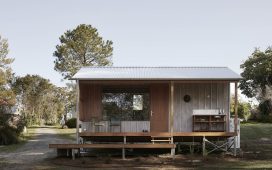
Public housing—the kind New Yorkers are most familiar with, slabs of brick surrounded by grass and asphalt—might not be everybody’s aesthetic cup of tea. Quite apart from the social problems and functional issues that have plagued the city’s 20th-century housing projects, the buildings themselves have not exactly been a hit with the architectural public. (They haven’t even been a hit with the people who live in them: only a few years after they were completed, James Baldwin noted that the residents “hate” them.) Yet the passage of time tends to endow all buildings, even unattractive ones, with a certain aura, turning them slowly into “unintentional monuments,” in art historian Alois Riegl’s famous phrase. In the case of public housing, the structures now stand as oddly poignant artifacts, testaments to an era when civic leaders acted boldly to provide better living conditions for working people.
That’s where Chris Cirillo steps in. The president, since 2012, of Harlem-based Ascendant Neighborhood Development, Cirillo leads a nonprofit organization with a 30-year track record of building affordable housing in Upper Manhattan. Founded as a Catholic charity, Ascendant has evolved over the decades into a multimillion dollar operation—but its latest evolution is its most intriguing yet. As part of the city’s still incipient (and still controversial) effort to save its distressed public housing, Cirillo’s company is partnering with the New York City Housing Authority (NYCHA) to make sweeping renovations to projects uptown, leveraging the buildings’ age and architectural history to secure government financing. It’s a rare approach, but in a chat with Dwell, Cirllio explains how public housing’s past could pave the way to its future.
How did you find yourself at Ascendant—and how did Ascendant find itself rehabbing public housing in New York?
CHRIS CIRILLO: It actually started for me when I was just out of college: I got a year-long fellowship working with the Parks Department. When that fellowship ended, I went over to Housing Preservation and Development (HPD); years later, I was in the private sector developing affordable housing, when a friend and former colleague of mine at HPD told me that Ascendant was looking for a new executive director. I applied, and here we are, almost 12 years later.
Ascendant has only been called Ascendant for about six years—we were called SFDS Development Corporation originally. The founding coincided with Mayor Koch’s housing plan to rehabilitate empty and underused buildings and sites around New York; our nonprofit organization acquired vacant city-owned properties and built on them, finishing about 800 apartments spread out across 28 buildings. Today we have a development pipeline that includes four new buildings that are going to add 600 more apartments to our portfolio, all in East and Central Harlem.
Given our history in the neighborhood, and our mission in affordable housing, the transition to preserving public housing felt like a natural one. Right now, NYCHA is looking at almost $80 billion in deferred maintenance in their portfolio, and a lot of that decaying housing stock is sitting right in our backyard in Northern Manhattan. Back in 2020, Ascendant finished a total rehab of three quarters of the buildings in our portfolio; doing that allowed us to qualify for PACT, the NYCHA initiative that allows private developers and nonprofits like us to get involved in renovating public housing in New York. We applied with several development partners, got two separate contracts, and we’re now working on 14 individual public housing buildings, spread out across nine different developments. We expect that two-thirds of those buildings will eventually be listed on the State and National Registers of Historic Places, making them eligible for historic tax credits both from New York State and the federal government.
Which is surprising, because presumably a lot of people don’t think of these buildings as being historic.
A lot of people feel that NYCHA developments as these buildings that destroyed the older historic fabric of many neighborhoods—it does seem funny that they’re now old enough to be considered historic, that they’re eligible for the National Register of Historic Places and that therefore they can get funding from those sources. The fact is, with regards to age, all a building or complex has to be is 50 years old to qualify. Most of the public housing developments in the city are at least that old.
But it isn’t just the date that matters. You have to also make the case as to why this particular building or complex is historic. That means doing the research. We have an historic preservation consultant who researches the history of these developments, how they were built, who the architect was and so on, making the case for us that the project in question is unique. That’s a whole piece of the process that happens early on, and it takes some time to do it. But it’s worth it: when you add up the historic tax credits from the federal government and from New York State, you’re talking about being able to get back as much as 40 percent of the cost of the improvements you’re making.
So what, exactly, makes a public housing project unique enough to qualify as a landmark?
One of the NYCHA developments we’re presently planning to rehabilitate is Metro North Plaza—a three-building development in East Harlem, built in 1971. In that case, there was one pretty obvious historic fact: the buildings were designed by William Lescaze and the landscape by M. Paul Friedberg. These were two of the most important modernist architects in America; Lescaze had designed what was basically the first modernist high-rise ever in this country, the PSFS Building in Philadelphia.
But ultimately, what allowed us to get the State and National Register listing was not the architectural aspect. Rather, it was the historic significance of the process that led to its design and development that was determined to be most important: specifically, the fact that a local neighborhood-based organization had advocated for redevelopment of this part of the neighborhood and ultimately convinced NYCHA to incorporate many of its ideas into the final project. It’s this rare instance of a community-driven public housing development, and that unusual feature is what allowed us to get it approved as a landmark and then to get the tax credits.
Most importantly perhaps: Is this scalable? Does this historic-tax-credit approach have real potential to fix public housing in the city?
We’re not the first team to do this with affordable or public housing. This approach is already being done with other projects—and historic tax credits have been a major source of funding for revitalizing housing for a long time. The reason you’re going to see more and more of it now is because of PACT, which exists because everyone realizes there’s this enormous backlog of work that’s needed to repair NYCHA’s portfolio.
The great thing about using the historic tax credits is that they allow us to do work on every aspect of the building, not just its architecture as such. We’re making improvements to common areas and landscaping as well as the facades, to plumbing, insulation, you name it. Again, it’s a lot of work to fine-tune the repair plan, to do the research necessary so that you get the tax credits: with every one of the fixes you do, you’re thinking, Okay, who has to approve those new windows, that new door? But in the end, it’s worth it, especially from the residents’ perspective. For all the complaints that NYCHA residents have about their buildings, they also care so much about their communities. It’s the residents who have spent years fighting for repairs, fighting for a quality environment. There’s this pride of place, and when you get these buildings officially recognized as being historic, that really tends to reinforce the feeling in the community that these buildings matter.
Top Photo of 114-116 E 102nd Street, an Ascendant-rehabbed property, by Sindayiganza Photography.
Related Reading:
Where Do Affordable Housing Experts Think the U.S. Crisis Goes From Here?
New York’s Favorite Sculpture Park Is Getting a Massive Renovation—With a Focus on Accessibility












